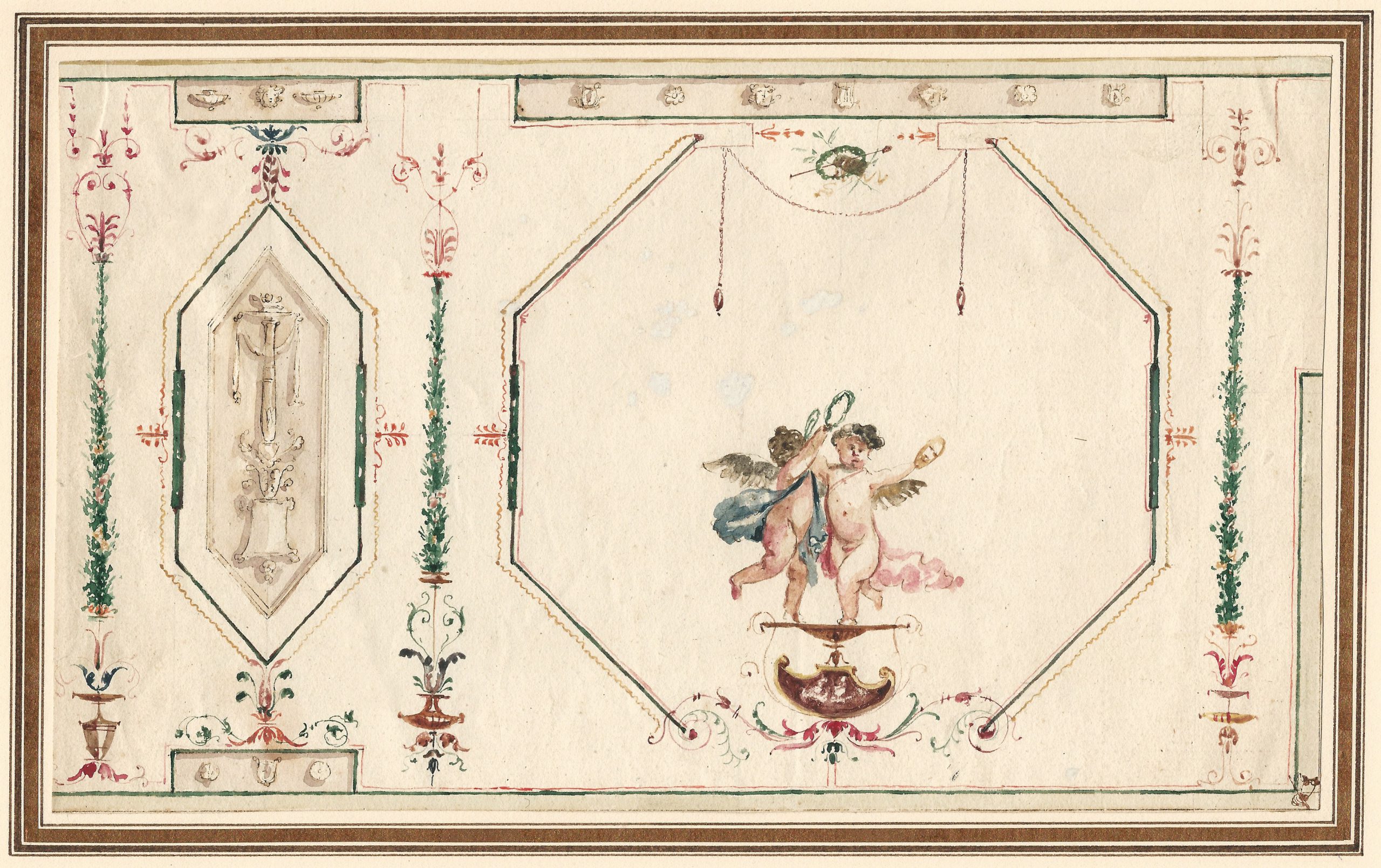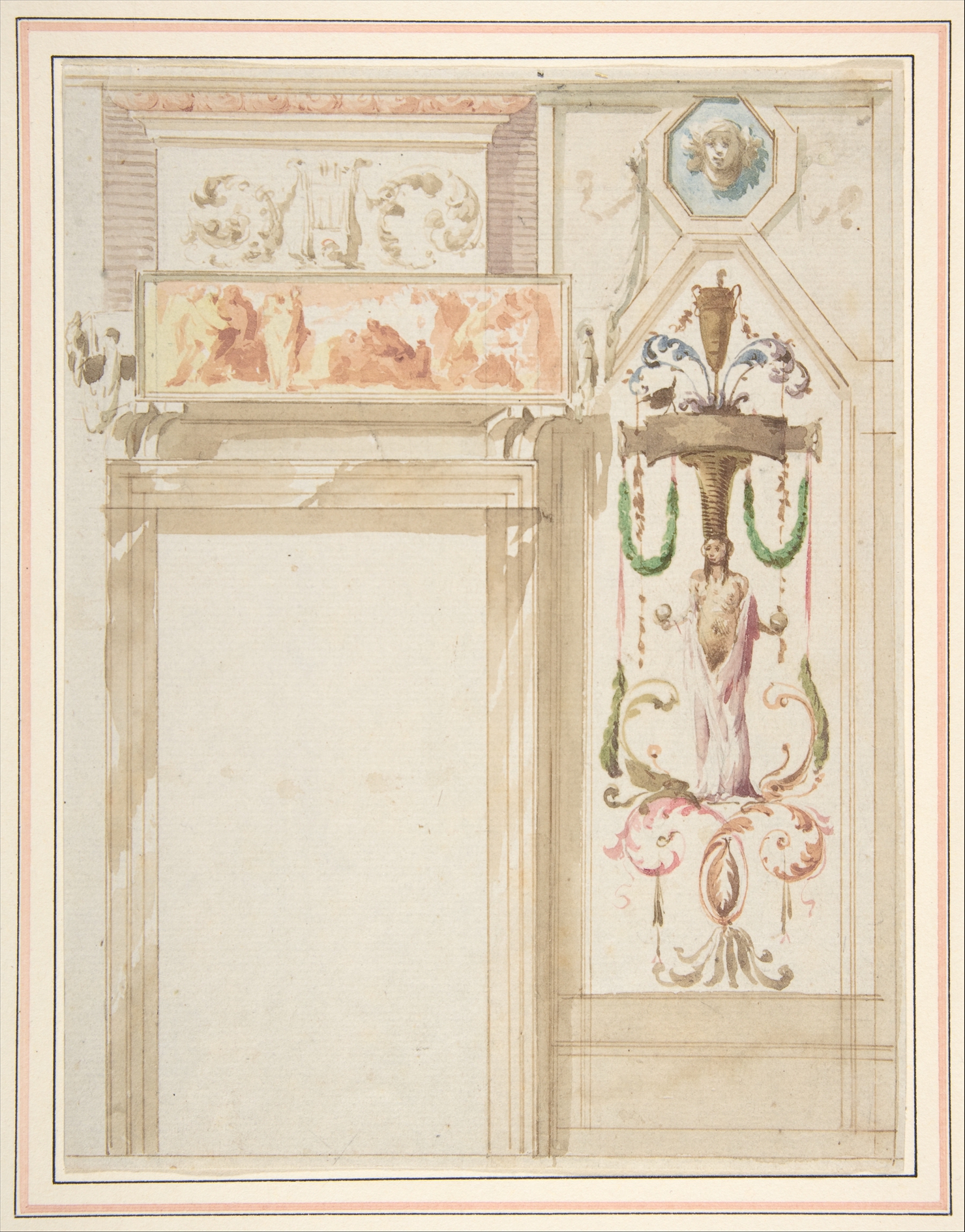GIUSEPPE BERNARDINO BISON (Palmanova 1762 – 1844 Milan)
Giuseppe Bernardino Bison (Palmanova 1762 – 1844 Milan)
Design for a Pompeiian Wall Decoration with Putti Dancing
Pencil, watercolour and bodycolour, remains of brown ink framing lines, on wove paper, 166 x 280 mm (6.5 x 11 inch)
Provenance
~ Sven Gahlin, 1965
~ Lodewijk Houthakker (1926–2008), Amsterdam (Lugt 3893 and 4533)
~ Private collection, Belgium
Literature
Peter Führing, Design into Art. Drawings for Architecture and Ornament: the Lodewijk Houthakker Collection, London 1989, vol. I, p. 207, cat. no. 201, repr.
Exhibited
~ R.D. Kollewijn, Wanden en Plafonds. Tekeningen uit de verzameling Lodewijk Houthakker, Nijmegen (Nijmeegs Museum ‘Commanderie van Sint Jan’) and Haarlem (Vleeshal) 1985, cat. no. 104
~ R.D. Kollewijn, A New World. Neo-Classical Drawings from the Collection of Lodewijk Houthakker, exh. cat. Oberlin (The Allen Memorial Art Museum) 1986, cat. no. 15
***
Giuseppe Bernardino Bison is one of the last and most delightful exponents of the 18th century Vedute tradition.1 He was trained in Venice by Anton Maria Zanetti and Constantino Cedini, a pupil of Tiepolo mostly remembered for his ceiling in San Barnaba in Venice. The early part of his career was spent working as a decorative fresco painter at villas and palaces around the Veneto. Around 1800 he settled in Trieste, where among his more important works were the decoration of the Palazzo Carciotti, painted around 1805, and the Palazzo della Vecchia Borsa, completed three years later. In 1831 Bison moved to Milan, where he worked for the remainder of his career, and where he was particularly active as a scenographer, producing stage designs for the Teatro alla Scala and other theatres. Although his career lasted well into the 19th century, his style invariably retains something of the flavour of the previous century.
Bison was an accomplished and prolific draughtsman, with an oeuvre of charming genre studies and landscapes in pen and ink wash or gouache. His earliest works show the influence of Giambattista Tiepolo and Francesco Guardi, while his later drawings tend towards Neoclassicism. His drawings encompass a wide and varied range of subjects, from religious narratives to genre scenes, Capricci, and stage and ornament designs. Few of Bison’s many drawings, however, were done as preparatory studies for paintings, and he seems to have produced a large number of his drawings as independent works of art for sale; this is certainly true of his pastoral landscapes in gouache. Significant groups of drawings by Bison are today in the collections of the Castello Sforzesco in Milan, the Musei Civici in Trieste and the Cooper-Hewitt Museum in New York.
The present sheet is a design for a fresco wall decoration in the Pompeiian style, which was highly fashionable during the dacades around the turn of the 19th century. Peter Führing has suggested a dating of our sheet of around 1780-1795,2 and compared it to designs by Bison in the collections of the University of Michigan.3 He noted that more elaborate projects on the same theme are preserved in the City Museum of Trieste and the Correr Museum in Venice, the latter of which are related to the decorations executed by Bison in the Palazzo Manzoni in Padua and the Villa Lancenigo and the Villa Breda in Piave.4 It can also be compared to a design by Bison for a wall decorated with grotesques in the Metropolitan Museum in New York (fig.).5
SOLD
1. For the artist, see A. Rizzi, Disegni del Bison, Udine 1976, F. Zava Bocazzi, ‘Gli affreschi del Bison’, in: Arte veneta, 22, 1968, pp. 142-66 and F. Zava Bocazzi, ‘Nuovi paesaggi e pitture di genere del Bison’, in: Arte veneta, 25, 1971, pp. 229 ff.
2. Peter Führing, Design into Art. Drawings for Architecture and Ornament: the Lodewijk Houthakker Collection, London 1989, vol. I, p. 207, cat. no. 201.
3. R.P. Wunder, Architectural and Ornament Drawings of the 16th to the early 19th Centuries in the Collection of the University of Michigan Museum of Art, Ann Arbor 1965, cat. nos. 101-02.
4. Führing, loc. cit.
5. Pencil, watercolour, 203 x 154 mm, inv. no. 67.707.1, Mary L. Myers, Architectural and Ornament Drawings: Juvarra, Vanvitelli, The Bibiena Family & Other Italian Draughtsmen, exh. cat. New York (The Metropolitan Museum of Art) 1975, cat. no. 18, fig. no. 18, p. 18.



